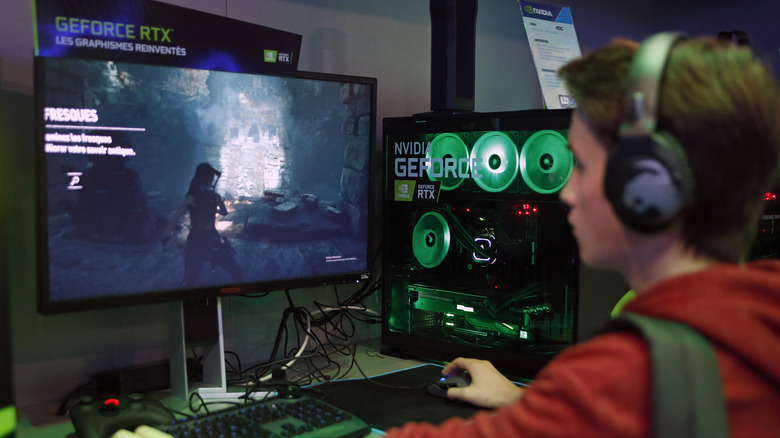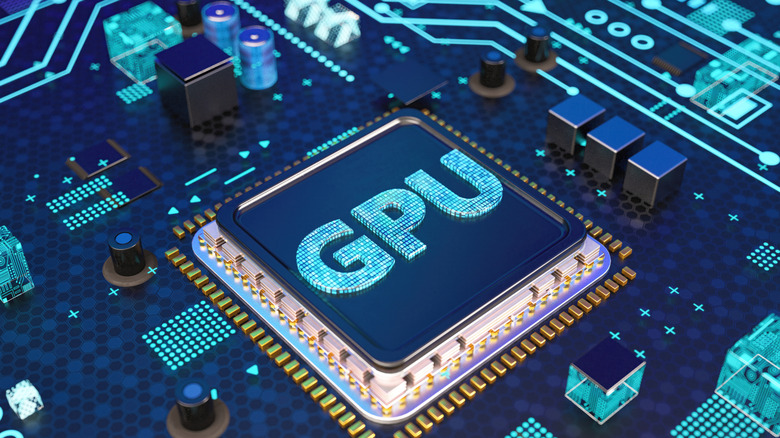What Does 'DLAA' On An Nvidia Graphics Card Actually Mean?
Whether you're building your own gaming PC or want to know more about the peripherals that power a next-gen rig, one of the most integral components of your machine is the graphics card, also referred to as the GPU. While there are a handful of GPU brands to choose from, Nvidia is the company that has dominated the marketplace for years. It's also the manufacturer behind exclusive features like Deep Language Super Sampling (DLSS) and the focus of today's explainer, Deep Language Anti-Aliasing (DLAA).
DLAA is an image-enhancing technology that uses machine-learning tools to create sharper, more refined visuals without upscaling a game's native resolution. When enabled, DLAA uses AI to refine gameplay visuals in real-time, resulting in less jagged edges, smoother fine details, and improved image stability.
While DLAA isn't supported by every PC game, it's a phenomenal optimization for players who value crisp cinematic visuals over frame rate gains (the latter is best tackled by Nvidia's DLSS tech). Because DLAA focuses on delivering near-pixel-perfect image quality, it's best to invest in a Nvidia graphics card with plenty of power and headroom to ensure your GPU doesn't sacrifice too much performance.
DLAA and DLSS: Options that put gamers in control
Nvidia's DLAA technology was released in 2021, and the first PC game that supported the feature was "The Elder Scrolls Online." Zenimax Online Studios developers worked alongside Nvidia to build DLAA into the game, giving players a way to experience the detailed character models and environments. Looping in a game developer was a smart move on Nvidia's part, allowing the GPU maker to confidently showcase how DLAA worked in a live, player-driven demo, instead of exhibiting the feature in a controlled tech-demo environment.
Both DLAA and DLSS train Nvidia GPUs by way of ultra-detailed high-res images fed to it by Nvidia supercomputers. The neural network learns how to predict the visuals of upcoming frames, which then generates the anti-aliasing algorithms that are loaded onto your RTX 20, 30, 40, or 50 Series GPU via driver updates. As of October 2025, DLAA is supported by a wide variety of PC games, including popular titles like "Cyberpunk 2077," "Baldur's Gate 3," "No Man's Sky," and many more.
As time goes on, developer support for Nvidia's DLAA technology will continue expanding. This means players can expect the setting in future AAA games and upcoming indie titles, too. With DLAA and DLSS as options you can toggle on or off in your game's graphical settings, gamers are able to choose between heightened visuals or a bolstered frame rate for a more personalized experience.
The future of visual fidelity in gaming
Graphics cards will only continue to evolve, and the neural networks that drive the AI algorithms of your Nvidia GPU are going to keep getting better, too. Game engines like Unreal and Unity are already incorporating these Nvidia features more regularly, which bodes well for the future of gameplay visuals and performance. It may only be a matter of months or years before DLAA becomes a standard PC game setting, positioned with other traditional anti-aliasing methods like Fast Approximate Anti-Aliasing (FXAA) and Temporal Anti-Aliasing (TAA).
The latter two AA technologies don't use AI at all — FXAA relies on a post-processing image filter to smoothen the edges of various gameplay elements, while TAA compiles information from several frames to cut down on in-game flickering and shimmer. Neither FXAA nor TAA is exclusive to Nvidia, which means you'll be able to find both features supported by other GPU brands. While FXAA and TAA are still relevant technologies for improving gameplay visuals, we could be seeing even more AI integrations for enhanced PC gaming sooner rather than later.


